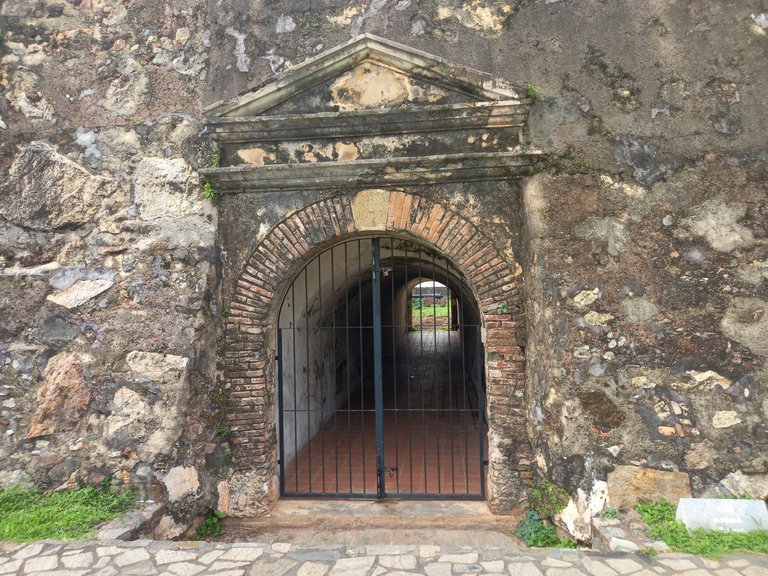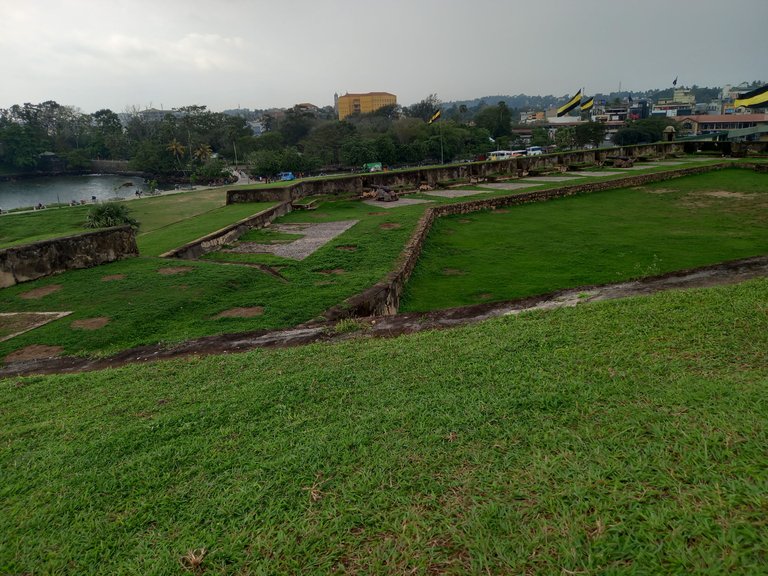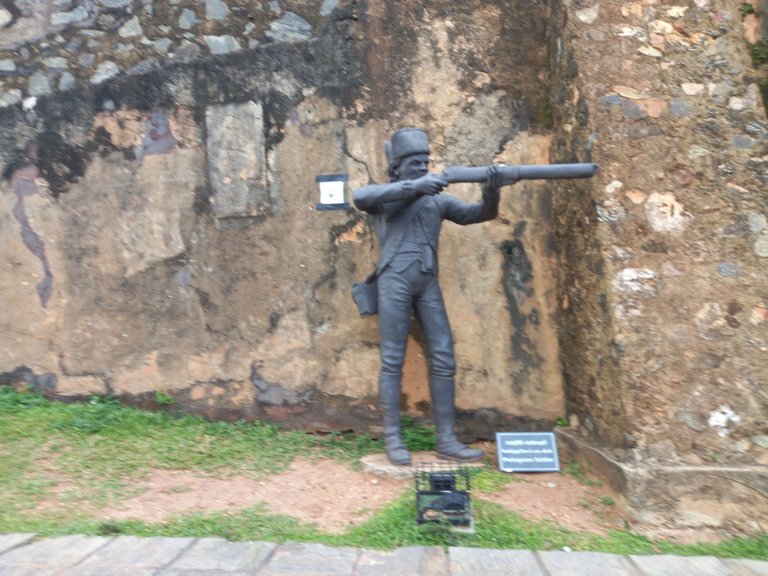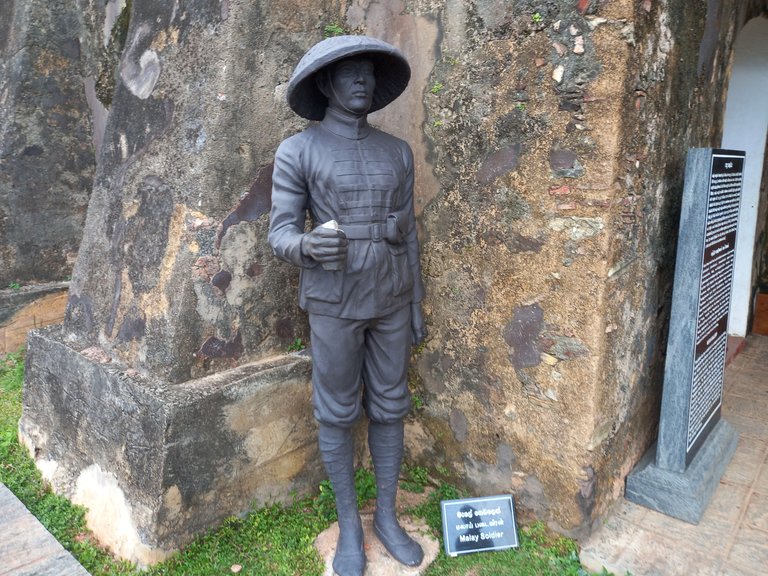Amazing architectural features of the fort built by the Portuguese during the colonial period to ward off enemy attacks.
Hello dear Architecture lovers,
What's up guys? Greetings from Sri Lanka. I haven't had a chance to be active in this beautiful community for more than three weeks due to my busy work situation. Prior to that, I had the opportunity to consistently publish content and engage with other content owners. However, I hope to be more energetic and active in the future by taking the missed time into my mind. Last Sunday afternoon, family members left with me for the nearest ancient city, Galle, to get rid of the monotony. Sri Lanka was ruled by a royal family in those days. But as a result of conspiracies within the palace, the foreign forces had to betray the country. The Portuguese army landed in Sri Lanka and managed to establish a colony in a short period of time. At that time, Sri Lanka was self-sufficient in agricultural crops and because it was a shipping hub, foreign nationals were very attentive. The Portuguese army conquered Sri Lanka for the same reasons. As the city of Galle had a natural harbor, the Portuguese army built a fort to protect it from the attacks of the enemy forces. That is what I hope to present with today's content.

Indeed, this fort is an amazing creation. This is a strong fort that was built by collecting large pieces of stone and even survived the Tsunami disaster that hit Sri Lanka in 2004. Although the entire city of Galle was completely destroyed by the tsunami waves, the Galle Fort, which is in contact with the Indian Ocean, was not damaged due to the strong architecture used during the Portuguese period. There are many secret doors inside this fort to ensure surveillance and security.

Galle Fort has also been certified by UNESCO as a place of historical heritage. It has a lot of attention from foreign tourists, and domestic tourists from all parts of our country also come. Galle Fort is a busy place on weekends. As well as the urban decoration, stone slabs have been built recently to walk to see the beauty of the fort. It brings convenience to every traveler.


Small trees have been formed in some places in this fort, which is made of black stone in an excellent manner. The administration is working to remove them before they grow too big, as this historical heritage may be destroyed if the trees grow too big. It is said that it was originally built by the Portuguese but later modified by the Dutch and British forces.


The fact that two name boards have been created with arrows to reach Sun Bastion, Moon Bastion and Vishmarkt Bastion provides great convenience to the explorers.


After climbing the steps of the Galle Fort, you can see the Indian Ocean, Galle Harbor and the Rumsala mountain range on one side. A swimming training school can also be seen below. Several guardhouses have been built in this fort to monitor the sea invasions of the enemies and for military activities. It is a pity that tourists are deprived of the opportunity to freely explore here due to the choice of these cabins for young couples to fall in love. A few years ago, young couples were banned from staying in the fort for the same reason. I recommend that the ban be reinstated because the Galle Samanala Park has been established for lovers to experience love.

 |  |
|---|
Inside the Galle fort, we saw a structure that shows the model very clearly. Here I observed the spread of buildings in the entire Galle Fort. The display of such creations allows foreign tourists to explore without difficulty.

The Galle International Cricket Stadium can be seen from the top of the Galle Fort Wall. When international test matches are held at this stadium, you can watch them from the fort. It is a great advantage to be able to observe many places around Galle city from here. These evidences are sufficient to call Galle Fort as a place of high tourist attraction.


It is a great advantage that we can still see with our living eyes the exact replicas of cannons used in the past. These were placed near the shelters as a war tactic.

Next, I came to the site of the military tower which was used as sun bastion during the Portuguese period. There is no attic to be seen today. But the history of Namapurve War Attala is given in Sinhala, Tamil and English. As mentioned in it, this war attic was built in the 16th century and it was called St. Iago. There is a tunnel leading to the lower floor and during the Portuguese period it was also known as the gateway to the interior of the fort. It is said that it was destroyed in the terrible battle of Galle fort by the Dutch in 1640. Here the plan is shown on the side.


In this fort, small cells were built to house the prisoners. Iron gates have been used for them.


Meanwhile, some beautiful structures full of architectural elements were also seen. It can be thought that they were created during the Portuguese period, but there is no definite evidence.

Next, we came to the Dutch clock tower in Galle Fort, which has a high value of ancient and historical value. Although it is a fort built by the Portuguese, it can be considered that this amazing clock tower was built by the Dutch. That may be the reason why it is known as the Dutch watch tower.

Dutch architectural forms can be seen as you approach this sturdy clock tower made of stone. The entrance has a gate and its shape is familiar Dutch style. Currently, tourists are not allowed to enter it.

Two holes can be seen at the top of this high clock tower, around which a strange kind of stone carving is carved.
 |  |
|---|
The Butterfly Bridge and Galle Park are visible from the other side looking out to sea. Green plants attract everyone. Ruins can be seen in some parts of the fort.


I was not ready to end this amazing quest of mine yet. This fort of historical value has many ruins and places to explore. I was very curious to go up and down the stairs to look at the amazing creations.


During that time, we got to see some sculptures of soldiers from the time when Sri Lanka was a colony. By seeing them, you can get an understanding of the appearance of the soldiers of that time. The first sculpture shows a Lascarine soldier. He doesn't seem to have a weapon. The second sculpture shows a Portuguese soldier. Holding a weapon in his hand, he looks bold as well as ready for war.


After that I saw a statue of a Malay soldier. Finally, a sculpture of an African slave soldier can be seen. During the rule of Sri Lanka by the Portuguese, slaves were brought from Africa and construction work was carried out here.


Further walking saw a unique architectural feature. There is a walkway and steps made of large seashells. Indeed, it is an attractive as well as a different kind of plan.

The floor of the Portuguese gunpowder warehouse can be seen in ruins. Names are engraved on the walls here by cynical people who have no love for historical places. In fact, legal punishment should be given to the people who do such work because similar mistakes are also being made to other historical places. We must protect places of historical value for future generations to see.


Looking down beyond the floor of the gunpowder warehouse, a ruined tunnel could be seen. It is a clear proof that the Portuguese fort had tunnels. Access to the tunnel is currently closed, so entry is not possible. In this way, after some time I was able to explore a place of historical value. See you in another content.


Congratulations, your post has been added to Pinmapple! 🎉🥳🍍
Did you know you have your own profile map?
And every post has their own map too!
Want to have your post on the map too?
It is understood that it is very old and the memory is confused. It looks very nice.
Yes of course. Every cultural mixed architecture had behind old history.
!ALIVE
@kawsar8035! You Are Alive so I just staked 0.1 $ALIVE to your account on behalf of @madushanka. (1/10)
The tip has been paid for by the We Are Alive Tribe through the earnings on @alive.chat, feel free to swing by our daily chat any time you want.

https://twitter.com/1260211375881814016/status/1635601432291291137
The rewards earned on this comment will go directly to the people( @madushanka ) sharing the post on Twitter as long as they are registered with @poshtoken. Sign up at https://hiveposh.com.
It is a very beautiful place, I think that is one of the few good things that brought the colonization those majestic constructions imagine you what I endure a tsunami.
On the other hand how nice to be able to talk to someone from Sir Lanka, I always only heard it in the movies hehe.
Yes, that past glorious construction built during the colonial period was strengthened to protect buildings and people from a disaster like a tsunami. Using such robust architecture tools will prove to be beneficial in every way in the future. Talking to a Sri Lankan like me is as much fun for me as it is for you.
!ALIVE
@soychalbed! You Are Alive so I just staked 0.1 $ALIVE to your account on behalf of @madushanka. (2/10)
The tip has been paid for by the We Are Alive Tribe through the earnings on @alive.chat, feel free to swing by our daily chat any time you want.

That's right and well, I learned something new srilankines is your nickname.
This fort is impressive, I definitely like the old constructions more than the current ones, I think they enjoy an aura that inspires peace even though it was built in theory probably for war, but its current state makes you feel that those times passed and life was victorious. I am also impressed that it survived the 2004 tsunami.
The scale model of the place is incredible.
Thanks for sharing. Best regards!
Yes indeed this fort has interesting architectural features. Exploring historical places is a chore, so I read history books in my free time. Although this fort was created to conduct a war, today it is an ancient place of importance.
!ALIVE
@musicandreview! You Are Alive so I just staked 0.1 $ALIVE to your account on behalf of @madushanka. (1/10)
The tip has been paid for by the We Are Alive Tribe through the earnings on @alive.chat, feel free to swing by our daily chat any time you want.

Hi @madushanka , the Galle fort is impressive and they have it in excellent condition. Unesco has declared it a cultural heritage site, how nice! ... I understand about the big rocks and that is why it is such a resistant construction. Imagine the men of that time lifting those huge stones to make those high walls. The truth had to be a titanic work.
In those days, as there was no use of machinery, our history books have shown pictures that make it possible to imagine that all such huge blocks of stone were lifted up by slave soldiers. Indeed, Galle Fort is an incredible and amazing construction.
!ALIVE
@tibaire! You Are Alive so I just staked 0.1 $ALIVE to your account on behalf of @madushanka. (2/10)
The tip has been paid for by the We Are Alive Tribe through the earnings on @alive.chat, feel free to swing by our daily chat any time you want.

Hiya, @lizanomadsoul here, just swinging by to let you know that this post made it into our Honorable Mentions in Daily Travel Digest #1818.
Your post has been manually curated by the @pinmapple team. If you like what we're doing, please drop by to check out all the rest of today's great posts and consider supporting other authors like yourself and us so we can keep the project going!
Become part of our travel community:
Appreciate your selection @lizanomadsoul. Thanks million.
Keep up the great work @madushanka 👍
Such a historical environment. I salute the ancient Portuguese army for such an effort used to sett up the building.
Whichever foreign army created this wonder should be appreciated for the historical value it has today.
!ALIVE
@agbogo! You Are Alive so I just staked 0.1 $ALIVE to your account on behalf of @madushanka. (3/10)
The tip has been paid for by the We Are Alive Tribe through the earnings on @alive.chat, feel free to swing by our daily chat any time you want.

wow, I definitely can't get over the amazement of imagining how epic moments were lived in this imposing fortress, I loved all the content in general, such as the impressiveness of its Dutch tower, it is impressive to think about how these people would do to build these imposing buildings without the help of the machinery that is currently owned, how much history within its walls, thanks for sharing, dear friend @madushanka Blessings 😊
The fact that there is no machinery and everything is done by slave human labor is clearly amazing. One person is not enough to lift this single stone. However, a lot of sweat and tears must have fallen behind this historic construction.
!ALIVE
@armasdiaze! You Are Alive so I just staked 0.1 $ALIVE to your account on behalf of @madushanka. (4/10)
The tip has been paid for by the We Are Alive Tribe through the earnings on @alive.chat, feel free to swing by our daily chat any time you want.

Greetings @madushanka. Happy to see you back here! I'm also glad you were able to explore an iconic heritage architecture of your country of Sri Lanka - the Galle Fort built by the Portuguese! It's simply amazing how it stood the ravages of time by surviving many centuries of changes. Definitely, a historic monument well-suited for its UNESCO record. Incredible! 👍☺️
I'm going to ask you the same question I relayed to @lileisabel about that fort's construction materials. Do you have an idea of the type of stone used for this ancient building?
Yes, I am happy to join this platform again after some time. We are fortunate to have been named Galle Fort as a World Heritage Site by UNESCO.
I will now answer your question. Stone quarries have been excavated in places full of rocks since ancient times in Sri Lanka. By breaking the rocks with big hammers, these big pieces of stone have been used to build the fort. The great labor of slave workers has been used to break the stones.
Indeed, these are astonishing methods of transporting the necessary stones from their origins to the final placement on the fort site. The manual labor alone of people is already a feat of epic proportions. Perhaps I'd rephrase my question. Do you know the name of the stone used for that fort's construction?
Generally we call these stones as black stones.
Okay I see. Thanks for the update! 👍
the fort looked very sturdy. I also always like to visit historical places because there are many exciting and amazing things that we can find there
Yes, as you mentioned, we can learn a lot by exploring historical places.
!ALIVE
@aquagelas! You Are Alive so I just staked 0.1 $ALIVE to your account on behalf of @madushanka. (1/10)
The tip has been paid for by the We Are Alive Tribe through the earnings on @alive.chat, feel free to swing by our daily chat any time you want.

Sri Lanka is one of the countries that have a lot of history and I am very happy to be able to see one of the histories based on your post. I'm curious about how the conditions were there when the Portuguese colonized.
nice post, thanks for sharing.
Sri Lanka is a very beautiful island with an ancient history and a land of amazing architectural techniques before colonization. The amazing architecture can be witnessed by seeing the stone structures built during the royal period which are still preserved. The Portuguese brought their own construction techniques.
!ALIVE
@wireloca! You Are Alive so I just staked 0.1 $ALIVE to your account on behalf of @madushanka. (2/10)
The tip has been paid for by the We Are Alive Tribe through the earnings on @alive.chat, feel free to swing by our daily chat any time you want.

I have a fasination of architectural heritage because of the story with in its walls. Althought he fort is weathered, it stood the test of time. I enjoyed reading the heritage attached to the place. Keep sharing!
Congratulations @madushanka! We are delighted to inform you that your outstanding publication was specially selected to be part of our Curated Content Catalog and was awarded SILVER MARK in Architecture Anthology™ 20. More power!
Thank you for subscribing to Architecture+Design, an OCD incubated community on the Hive Blockchain.
Appreciate your selection and finally I came to silver mark.
Continue publishing amazing stories about architecture and design dear @madushanka Always a great pleasure to serve you! 😀